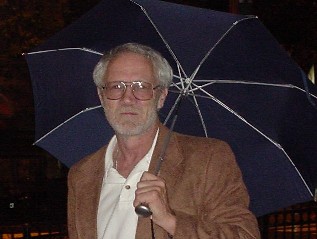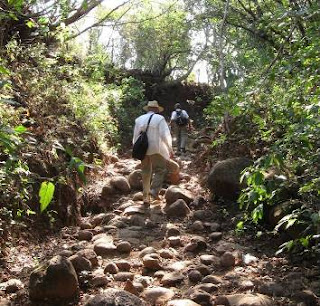This was an interesting visit with an author whose mystery novels take place “South of the Border.” If you are looking for a mystery that has a unique twist, then Robert Richter novels are stories you will want to read.
In Robert Richter’s Own Words:
I have a relationship with west coast Mexico that goes back forty years and lived in the Nayarit coastal village culture off and on for over two years, before that region was much known beyond the limits of Puerto Vallarta. I return frequently. However, I have lived on the remnants of a family homestead in southwestern Nebraska for thirty-five years. I farmed once, very small-time, dry land wheat to earn my place to live. Since giving up my own farming, I have done itinerate farm labor, substitute teaching, and I conducted escorted excursions in Latin America for small groups for ten years.”
During that time, I was also publishing: a book of poetry in 1980, and a regional high plains history in 1987. I have written for regional and national literary magazines and quarterlies, including Prairie Schooner, Bloomsbury Review, Sport Literate, Raven Chronicles, and others. In 1991 my first Algo novel, "Something in Vallarta,” was published.
"Homefield," a novel about farm life and returning Vietnam vets trying to start life over in their small town cultural landscape, and was published in 2000. That same year, I also published a biography for young readers of Cuauhtémoc Cárdenas of Mexico, and I was awarded the Distinguished Merit Award from the Nebraska Arts Council for my work in nonfiction. In 2007-8, I was a Fulbright Research Fellow, writing and doing historical research in Buenos Aires for the year. Since then, writing has been my full time occupation, except when I am nannying my five year old granddaughter.
Tell us about the genre of your work.
I like to write mystery/suspense novels, particularly cross-, or inter-cultural mysteries, setting questionable American attitudes and perspectives against those of lesser known and more modest “foreign” cultures. I like to “preach and teach,” I suppose, but unless that stuff is hung in an entertaining story. A mystery should be, first of all, an entertaining read.
Why did you choose this genre?
I write many different kinds of things, but mostly I am a pretty boring historian. A good plot is my biggest challenge, and generally speaking, mysteries are plot driven stories. It is a real challenge to put interesting history and culture into a story someone wants to read and then does not realize s/he’s learning something, too.
My published novels are Something in Vallarta, (Sag Harbor, NY: Permanent Press, 1991); Homefield: Sonata in Rural Voice, (Omaha, NE: Backwaters Press, 2001); and Something Like a Dream, (Ogallala, NE: Plain Ventures Press, 2010).
Something in Vallarta, (ISBN 1-877946-09-5. Sag Harbor, NY. Permanent Press, 1991). Cotton Waters is a young American expatriate hiding out on the Mexican west coast in 1972. An ex-student, ex-political activist with uncertain draft status and pending legal problems, he has lived incognito for over a year along a tropical frontier of fishing villages and empty beaches, thriving on cantina life, beachcombing, jungle slumming, and playing second base for a local village baseball team. He is an illegal gringo alien, living a lazy village life and known to his cantina buddies as “Algo”--Something in Spanish.
Armed with a little Spanish and a passion for the Mexican coastal culture, he is a disillusioned dropout, waiting for the rest of the world to regain some sanity. When his money finally runs out, Algo reluctantly goes into Puerto Vallarta to find work for wealthy Americanos who live in Gringo Gulch so he can maintain his tropical hiatus. Aided by a slick village friend who lives off vacationing American women, Algo soon finds himself in a "poor man's" sport car, following a beautiful woman for a jealous lover, and living the Vallarta jet-set lifestyle.
As the chase leads away from the bright resort lights of the Mexican Riviera into the tropical mountains, Cotton Waters encounters a class of gringos living by their own particular set of values that all but excludes the Mexicans and their culture. He also finds himself an unwitting decoy in a drug trafficker's double-cross, and now his only hope of escape is in the hands of the villagers whose way of life he has embraced.
Homefield: Sonata in Rural Voice, (ISBN 0-9677149-2-3. Omaha, NE: Backwaters Press, 2000). At the end of the Vietnam War, Calvin Parsons, a war resistor who fled the country to Mexico, come back to his childhood home to work on the family farm, only to run into the start of the farm crisis of the early 1970s. Buckwheat Van Anders, a childhood friend and now a crippled victim of the war is also trying to start life again. This is the story of an end of a cultural and farming era on the tablelands and plains around the fictional Platte River town of Revere, Nebraska. It is about the beginnings of one man’s understanding of himself and where he comes from, and of the bonds of friendship, family, and land.
Available from the publisher’s website
Something Like A Dream, (ISBN 978-0-9845647-0-5. Ogallala, NE: Plain Ventures Press, 2010). Cotton Waters is a gringo expat, scrounging up a lazy village living and a little beer money from of the Puerto Vallarta tourist trade as a private hustler of a Mexican Riviera lost-and-found--helping some people get lost and finding others--if the price is right or the client’s cause worth the time and interest. When Corina Springfield asks him to find her husband, heir to the Springfield Foundation, ex-cultural guru of the Aquarian Age and protégé of Timothy Leary, missing and presumed dead for over three year, Vallarta’s “Something” isn’t sure he can find her husband, but he knows he wants to try.
For more reasons than he is willing to admit. His manhunt for a mad shaman takes Waters into a blind obsession and into the sierra culture of the Huichol, one of Mexico’s most mysterious indigenous peoples. On this strange pilgrimage, Waters will find a whole new perspective on reality and dream, on deceit, self-deception, and human spirituality in a miraculous healing ceremony that will change his life forever or simply end it.
This is the second novel in the “Something” series, set in the coastal village culture of western Mexico. It is available from the publisher’s website, http://www.plainventurespress.com/
How do you come up with the names of places and characters in your books?
I try to write accurately about the cultural landscape that my stories take place in. Therefore, places are usually real places; settings are real settings. The action and plot in place and set are the fiction. Character names are difficult for me. Dickens was the best with character names. I try to use names I associate with the look and/or personality of the character. With Cotton Waters, the protagonist of my “Something” series, I wanted an unusual pairing—cotton and water are sort of opposites to me—and, I was specifically looking for a play on words. The word algodon in Spanish means “cotton.” If you wanted to shorten the word into a nickname, you could use algo, which means “something” in Spanish.
How did you develop the character of your protagonist in this book?
I was “something” of a Cotton Waters in my college days, traipsing around Mexico and repudiating the American way of life during the Vietnam War. Waters is an exaggeration, of course. I was never tough, clever, or cool and controlled like Cotton Waters. The great thing about fiction is that you can recreate yourself in your characters, be and do what you never could in reality.
What about an antagonist…is there a unique “bad guy” or a recurring nemesis of any kind?
Colonel Reyes appears in both “Something” books, but he’s just your everyday bad guy I can insert anywhere anytime to mess with the protagonist, to bring in red herrings, to add another complication. The real antagonists vary, and are (for me) usually harder to discern. They are regular people with irregular measures of human weakness like greed, jealousy, hate, self-righteousness, etc.
What is your favorite thing about your book?
In “Something Like a Dream,” it is the rendering of one culture’s ideas of reality in or against another culture’s version of the same thing while telling a compelling tale.
How is writing in the genre you write, different from other genre?
A mystery is an entertainment with characters, and a story bigger than everyday life. I write history, too, for instance, and the challenge there is to make the truth and the facts of everyday life a compelling tale.
Why and when did you begin writing?
I picked up a James Bond paperback in 1966 and decided I was going to write stories like that. I was in the first MA writing workshop at Colorado State University in 1973. I left the program in 1975 to farm and to write on my own.
What is your writing schedule?
Generally, I work during the winter months when I am pretty shut in on the Nebraska prairie. Only in the last couple of years has writing become more a full-time occupation.
I recently finished a history book called “Search for the Camino Real: a history of San Blas and the road to get there.” It is about this little known historical port in Mexico and my personal search for parts of the old Spanish colonial road across Mexico. I am finally working on a multi-genre novel/memoir about Buenos Aires, Argentina, where I was a Fulbright Research Fellow in 2007.
What kind of advice or tips to you have for someone who wants to write (especially mystery)?
I do not like to give such advice. I say, do not do it. For me, writing is some kind of a disease. I do it because I am driven to do it. There are far easier ways of living with yourself.
What do you do when you are not writing?
I travel as much a possible, usually in Latin America. I still do itinerate farm labor for neighbors. I garden and have a green house. I have helped nanny my granddaughter.
What “Made It” moments have you experienced in life?
When I was a Fulbright Fellow, I was living and writing in one of the great cities of the western hemisphere, exactingly as I had often dreamed. I went around the streets of the city for months with a cat-who-ate-the-canary grin.
Is there anything else you would like to add about your books?
Yes, I just want to add one more thing about my Something books, and that is that The Huichol Indians of the High Sierras are the real people of Something Like a Dream's story.
Is there anything else you would like to add about your books?
Yes, I just want to add one more thing about my Something books, and that is that The Huichol Indians of the High Sierras are the real people of Something Like a Dream's story.
 |
| Huichol shamans on a sacred journey to gather peyote for religious festivals. |
 |
| A Huichol family in native dress. |
 |
| An example of a Huichol yarn painting like the one Cotton Waters must create at the end of the book, |









No comments:
Post a Comment